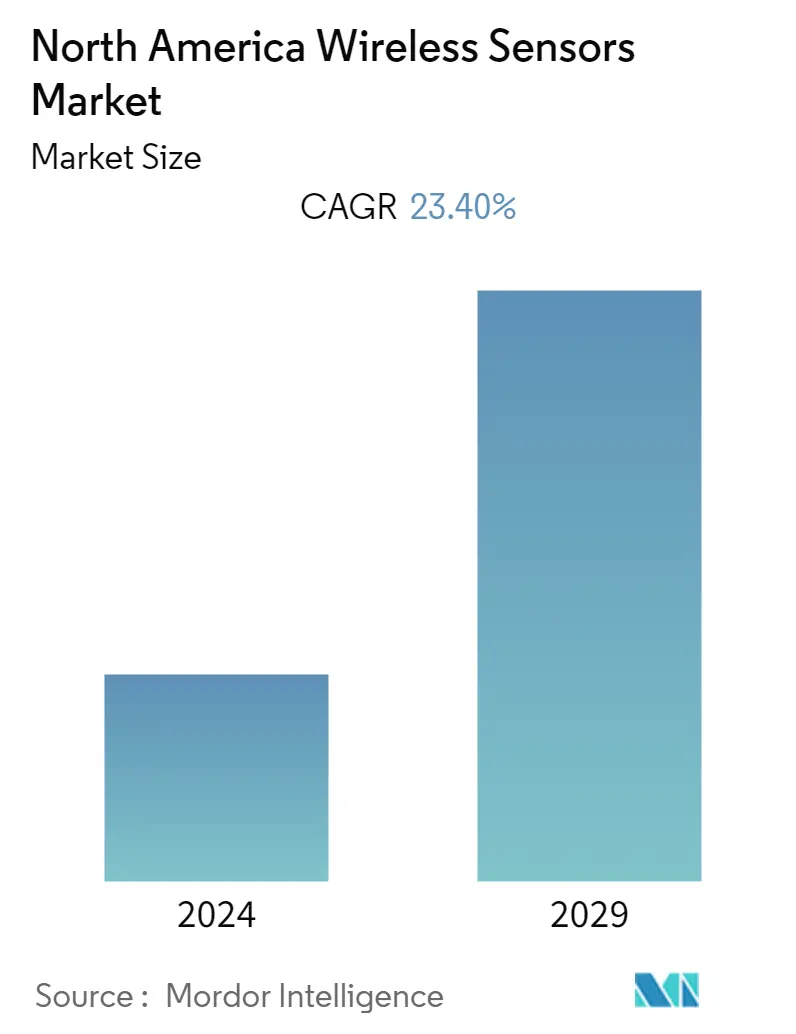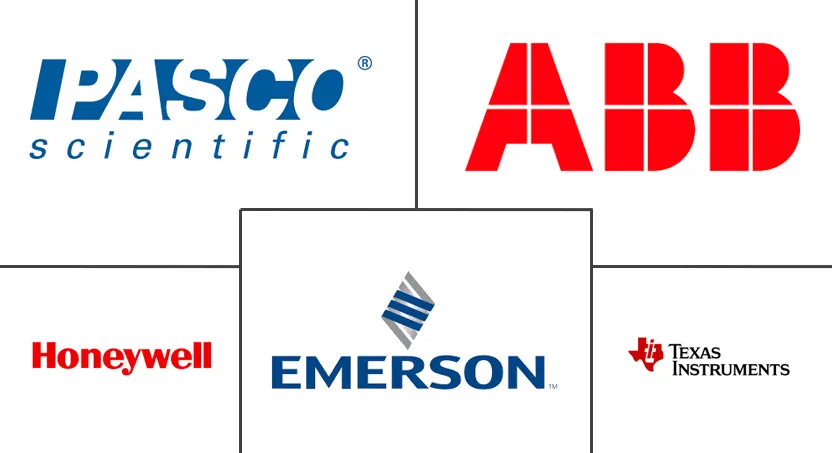Market Size of North America Wireless Sensors Industry

| Study Period | 2019 - 2029 |
| Base Year For Estimation | 2023 |
| Forecast Data Period | 2024 - 2029 |
| Historical Data Period | 2019 - 2022 |
| CAGR | 23.40 % |
| Market Concentration | Medium |
Major Players
*Disclaimer: Major Players sorted in no particular order |
North America Wireless Sensors Market Analysis
The North American wireless sensor market is expected to register a CAGR of 23.4% during the forecast period (2021 - 2026). The growth in Industry 4.0 with the COVID-19 pandemic on the global scale has been acting as a catalyst that pushed the development of intelligent wireless sensors that help improve energy consumption with a high level of efficiency in the region. The growing range of pressure applications in industries contributes to the development of single devices that can handle a range of pressures. Such devices are developed to simplify product designs, accelerate time to market and reduce sensory inventory costs of industrial manufacturers.
- Wireless sensors help to automate communication between critical systems and mitigate future problems for different utilities. For instance, water leak sensors can be mounted on walls to detect plumbing failures or pipes that may burst in the winter. Similarly, wireless rope sensors are being used in server rooms and data centers to detect the presence of water near computer hardware.
- These sensors also support disaster management efforts. For instance, in Texas, wireless sensors are being installed on bridges to detect water levels above a certain threshold, thus, indicating potential flash flooding in the area. Wireless vibration sensors are used in industrial plants with large machinery to predict equipment failures before they occur.
- Many companies are investing in wireless technologies in the region, which are cost-effective, safe, and convenient. For instance, SPM Instrument AB, a provider of condition monitoring technology and products, announced the release of Airius, a range of wireless vibration sensors for remote monitoring of industrial equipment. This sensor is a wireless, battery-powered vibration sensor ideal for remote condition monitoring of standard production equipment, such as pumps and fans.
- The increasing military spending across the region paves the way for technologies like drones/unmanned aerial vehicles (UAVs). In addition, the usage of wireless sensors in traditional fighter jets with high-end navigation systems is increasing significantly. The factors mentioned above are creating an exponential demand for wireless sensors in volumes as well.
- Further, the defense sector in the region is embracing wireless sensor technology, as these sensors can help organizations monitor their premises, identify suspicious activity, and track valuable assets. Moreover, they also find applications in banks. They can turn wireless push buttons into panic buttons for employees and retailers to install wireless window sensors on every building access point.
North America Wireless Sensors Industry Segmentation
The study characterizes the wireless sensors market based on the type of wireless sensors, the end-user industry, and the country. Wireless sensors are measurement tools for monitoring and recording the physical conditions of the environment. They are equipped with transmitters that convert signals from process control instruments into a radio transmission. These sensors have various applications in numerous sectors, such as automotive, healthcare, aerospace, etc. These have formed the part of the study in considering the end-user industry estimation. The scope of the study is currently focused on key regions, such as the United States and Canada. Further, to arrive at the overall market projections, the study analyzes the impact of COVID-19 and the investment scenario and other macro-economic factors.
| By Type | |
| Pressure Sensor | |
| Temperature Sensor | |
| Chemical and Gas Sensor | |
| Position and Proximity Sensor | |
| Other Types |
| By End-user Industry | |
| Automotive | |
| Healthcare | |
| Aerospace and Defense | |
| Energy and Power | |
| Food and Beverage | |
| Other End-user Industries |
| By Country | |
| United States | |
| Canada |
North America Wireless Sensors Market Size Summary
The North American wireless sensor market is experiencing significant growth, driven by advancements in Industry 4.0 and the increased demand for intelligent systems that enhance energy efficiency. The COVID-19 pandemic has further accelerated the development and adoption of these sensors across various sectors. Wireless sensors are becoming integral in automating communication between critical systems, thereby improving operational efficiency and reducing costs. Their applications range from detecting water leaks in infrastructure to monitoring industrial machinery for predictive maintenance. The defense and automotive sectors are also witnessing a surge in the use of wireless sensors, with military applications in drones and UAVs, and automotive advancements in electric vehicles and autonomous driving systems. This trend is supported by ongoing investments in wireless technologies, which are seen as cost-effective and convenient solutions for modern challenges.
The market is characterized by a high level of competition, with numerous vendors offering innovative wireless sensor solutions to both domestic and international markets. Key drivers of market growth include the increasing adoption of smart devices, the need for renewable energy monitoring, and rapid technological advancements in the United States. The automotive industry's shift towards electric vehicles is significantly boosting the demand for wireless sensors, particularly for battery monitoring and vehicle automation. Additionally, the market is witnessing continuous product innovation, with companies like Kryton International Inc. and Everactive leading the way in developing advanced sensor technologies. The competitive landscape is moderately fragmented, with major players focusing on expanding their global presence and enhancing their product offerings to capture a larger market share.
North America Wireless Sensors Market Size - Table of Contents
-
1. MARKET INSIGHTS
-
1.1 Market Overview
-
1.2 Industry Value Chain Analysis
-
1.3 Industry Attractiveness - Porter's Five Forces Analysis
-
1.3.1 Bargaining Power of Suppliers
-
1.3.2 Bargaining Power of Consumers
-
1.3.3 Threat of New Entrants
-
1.3.4 Threat of Substitutes
-
1.3.5 Intensity of Competitive Rivalry
-
-
1.4 Technology Snapshot
-
1.5 Assessment of the Impact of COVID-19 on the market
-
-
2. MARKET SEGMENTATION
-
2.1 By Type
-
2.1.1 Pressure Sensor
-
2.1.2 Temperature Sensor
-
2.1.3 Chemical and Gas Sensor
-
2.1.4 Position and Proximity Sensor
-
2.1.5 Other Types
-
-
2.2 By End-user Industry
-
2.2.1 Automotive
-
2.2.2 Healthcare
-
2.2.3 Aerospace and Defense
-
2.2.4 Energy and Power
-
2.2.5 Food and Beverage
-
2.2.6 Other End-user Industries
-
-
2.3 By Country
-
2.3.1 United States
-
2.3.2 Canada
-
-
North America Wireless Sensors Market Size FAQs
What is the current North America Wireless Sensors Market size?
The North America Wireless Sensors Market is projected to register a CAGR of 23.40% during the forecast period (2024-2029)
Who are the key players in North America Wireless Sensors Market?
Honeywell International Inc., Emerson Electric Co., Texas Instruments Incorporated, ABB Ltd and Pasco Scientific are the major companies operating in the North America Wireless Sensors Market.

